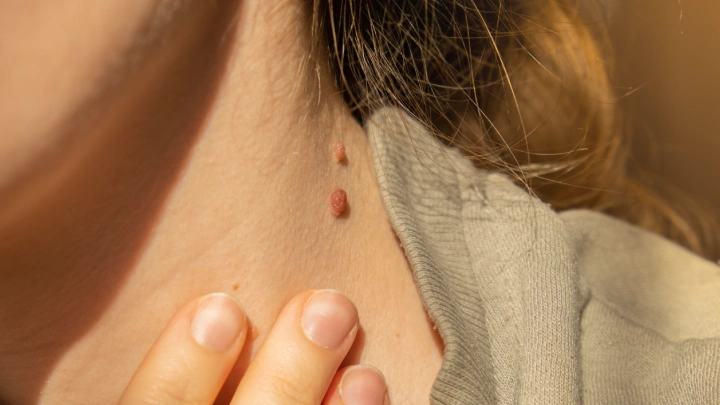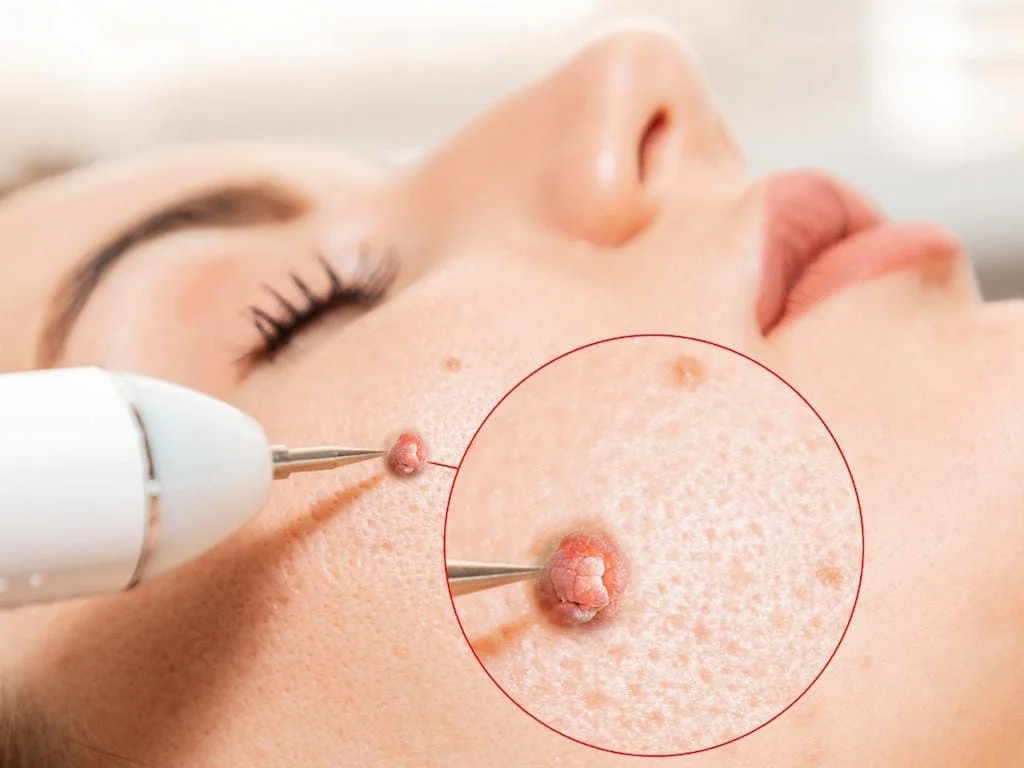If you have noticed small soft growths on your neck, underarms or eyelids there’s a good chance they are skin tag removal. While skin tags are usually harmless they can be really uncomfortable especially when they get caught on jewellery or clothes and some people might also feel self-conscious if they appear in visible areas.
The major issue that most people are facing is what to do about them. Some people consider skin tag removal (done professionally) while others prefer home remedies. But with home remedies, there are several things that you need to consider, such as pain, scarring or making things worse. And not everyone wants to visit a clinic without understanding their options.
That’s why this guide will walk you through what skin tags are, why they appear and how you can remove them safely. We’ll go over causes and all the skin tag removal methods so you can make an informed choice.
What Are the Causes of Skin Tag Formation?

Skin tag are basically small, soft, and flesh colored growths that hang off the skin. Medically, they are harmless and non-cancerous, made up of loose collagen and blood vessels trapped under the surface. Most skin tags are tiny, they are around 1 to 5 millimeters, but they can grow larger, sometimes up to a few centimeters.
Skin tags are smooth and slightly raised and they also have a little stalk at the base, which is why they are called pedunculated.
Around 50-60% adults develop skin tags at some point due to different health factors.
So why do skin tags show up in the first place? There are a few common reasons. Friction is a big one, along with things like hormonal shifts and weight gain. Some people are just more prone to them than others.
Friction:
Friction seems to be a major factor. Skin tags usually show up in places where skin rubs against itself or against clothing like the neck, underarms or groin causing friction. This constant movement and irritation may lead to small overgrowth of tissue.
This constant movement and irritation may lead to a small overgrowth of tissue.
Hormonal Changes:
Next up, hormonal changes also play a role. Sometimes people develop new skin tags during pregnancy and it is mainly because of the shifts in hormone levels or increased friction from weight gain.
There is also some anecdotal evidence linking skin tags to HPV, but more research is needed in this domain.
Underlying Conditions:
Now, if we check things from a health standpoint, skin tags have been connected to a few underlying conditions as well.
For instance, people with obesity, type 2 diabetes, metabolic syndrome or even high blood pressure seem to develop them more often. There is a clear link between insulin resistance and skin tag formation, which is why they are sometimes seen as an external marker of internal imbalances.
Genetics:
Genetics can also play a role. If skin tags run in your family, you may simply be more prone to getting them. In some rare cases, they have been associated with certain genetic conditions such as Birt-Hogg-Dubé syndrome, though that’s not common.
Professional Skin Tag Removal Methods:

If you are considering skin tag removal, then a medical setting is the safest way to do it. And essentially, if the tag is large or in a sensitive spot, then go with a medical procedure. Most procedures are quick, low-risk and done right in the clinic. Let’s take a look:
Cryotherapy:
Cryotherapy is one of the go-tos for skin tag removal. In this method, the doctor applies liquid nitrogen to freeze the tag off. It usually works best for smaller tags and has a low chance of scarring.
Excision:
Excision means cutting the tag off with a small scalpel or surgical scissors. It is often used for larger or more raised tags and the area is numbed first so you won’t feel much.
Electrocautery:
This method involves using an electric current to burn the tag off and it is quite helpful if bleeding control is important.
Laser Removal:
Laser removal, often using Nd:YAG or CO₂ lasers, is precise and sometimes a better option for sensitive spots like the eyelids.
For all of these, your doctor will apply either topical or local anesthesia to keep things comfortable.
If the tag is larger than 1 cm, your provider might send it in for a biopsy, just to be sure it’s not something else. That part can add around $50 to $200 to the bill, depending on the clinic.
Natural Remedies for Skin Tag Removal:
Some people try tea tree oil or apple cider vinegar to dry out skin tags at home. These methods can work over several weeks but there is a little clinical proof and they often cause skin irritation, especially in sensitive areas.
I would say avoid trying to cut or tie off a tag yourself because it can be risky. Doing that can lead to bleeding, infection or even worse if the growth isn’t actually a skin tag.
In rare but serious cases, people have tried treating what turned out to be a melanoma, mistaking it for something harmless so be careful.
Recovery & Aftercare for Skin Tag Removal:
After getting a skin tag removed by a professional, healing usually takes around one to two weeks. A small scab typically forms, then fades along with some redness.
I would recommend keeping the area dry but after a few days you can wash it with mild soap, you can also use a thin layer of antibiotic ointment to lower the risk of infection.
Final Words:
Skin tags are quite common and harmless. They are usually more of a cosmetic issue than a medical one but that does not mean you have to keep them if they are bothering you.
It doesn’t matter if you are looking into professional treatment or home options, having the right information is your first step and we are here to guide you through it.
